Contact: +91 99725 24322 |
Menu
Menu
Quick summary: Discover the transformative world of regenerative agriculture, where sustainability meets innovation. Explore holistic practices that rejuvenate soil health, foster biodiversity, and create resilient ecosystems. Dive into the future of farming that goes beyond sustainability, promising a nourishing and flourishing planet for generations to come.

Regenerative agriculture transcends mere buzzword status; it represents a sustainable farming methodology poised to contribute significantly to the planet’s well-being. So, what exactly is regenerative agriculture, and how does it operate? In essence, it’s a holistic strategy that surpasses traditional farming practices, aiming to foster robust soil health, amplify biodiversity, and mitigate the adverse environmental effects associated with agriculture. Unlike traditional farming methods, regenerative agriculture focuses on restoring and enhancing the natural resources utilized in cultivation, aiming to leave the land more fertile and resilient for future generations.
Net Zero Roadmap shows that nearly two-thirds of our greenhouse gas emissions come from agriculture, so addressing these emissions is essential.
Agriculture generates 19 – 29% of total greenhouse gas emissions. Also, one-third of the food produced is lost or wasted globally. Addressing this food loss is critical to reducing the climatic stress on the environment.
A 2020 report found that 690 million are hungry and the world will need to produce 70% more food to feed the 9 billion population by 2050.
If the number of resources and the amount of process that a food product goes through to be produced is enormous. Intake of resources like land, water, labour, livestock, etc and the processes like processing, storage, packing, logistics, etc amount to the release of atmospheric gasses contributing to global warming. Food is such an essential component and also its volume of intricacies makes it difficult to reduce greenhouse gas emissions.
Therefore, the need for change in production methods is overdue. Technological innovation in this field such as recording data, efficiency in production, emission reduction, waste management, etc contributes to reducing the emission of harmful gasses.
Learn how sustainable farming practices can mitigate environmental impact and ensure food security for future generations.
Discover the intersection of climate change and agriculture
Regenerative Agriculture is based upon a philosophy that seeks to replicate the structure and function that is equivalent natural systems in the design similar to biologically healthy and resilient farm systems. Regenerative farming requires a mindset that is structured, systems-based, place-based, and positive-outcome oriented. Regenerative design is approach where the output of a system improves the health and resiliency of that system over the time.
Let’s understand it in broader way, on one end is degenerative and on other is regenerative. Degenerative includes the processes/practices that decrease the health and wellbeing of a land and even ecological and social degradation of soil. Whereas regenerative agriculture is known for renewing the degraded systems while maintaining (or even increasing) production.
Regenerative agriculture is a farming practice that embraces the principles of sustainability and aims to restore the degraded farmland back to a state of health while sustaining its land-based income to those who depend on it for their livelihood. This practice has been gaining popularity among farmers and consumers alike, as it offers a more natural approach to agriculture that is not only beneficial to the environment but also helps to improve the productivity and resilience of farms.
By keeping the soil rich and healthy, regenerative agriculture can create healthy food for consumers to eat. Regenerative agriculture is not just about reducing harm – but seeks to improve the health of the land, waterways, the animals that live on it, and people that benefit from it. As our population expands and demand for resources increases so too do the strains of acquiring our resources in ways that blend in with the natural function of ecosystems. The sustainable production of resources must ultimately be blended in with sustaining healthy natural ecosystems.
Despite a large spectrum of applications, there are five overarching principles of regenerative agriculture:
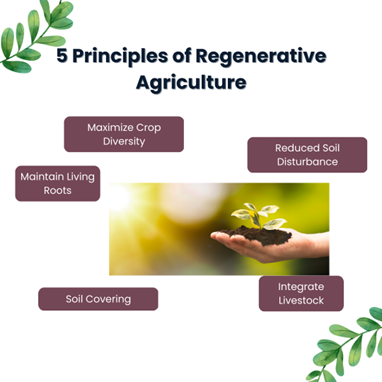
Ploughing associated with conventional agriculture exposes bare soils for extended time periods. Exposed bare soils often result in the the oxidation and release of soil organic carbon from the soil into the atmosphere as CO2. Whereas, in conventional agriculture, CO2 is lost from bare land to atmosphere. Whereas, in regenerative agriculture, practicing no-till and usage of cover crops can reverse the process resulting in more CO2 being stored as SOC in the soil than is released into the atmosphere.
Conventional Agriculture induces monoculture styled cropping, ploughed soil, application of synthetically produced fertilizers, insecticides and pesticides has greatly reduced the diversity and adaptability of agricultural soil to climate change whereas, Regenerative agriculture improves crop resilience and benefits soils. In addition to raising Soil Organic carbon.
Moreover, regenerative agriculture enhances water holding and retention parameters of soil and enhances pest resistance.
Equilibrium between production and ecosystem health can be understood by considering an instance, fostering native insects and birds can support the pollination of crops. Supporting grassland birds can mitigate livestock pest pressure. Wildlife can co-exist with and benefit food production. The practice of decreasing tillage can protect soil biota and fungal networks that improve soil fertility and water infiltration, reducing soil erosion. This allows for less chemical fertilizer use, cutting costs. Production can improve at the same time that small faunas are protected.
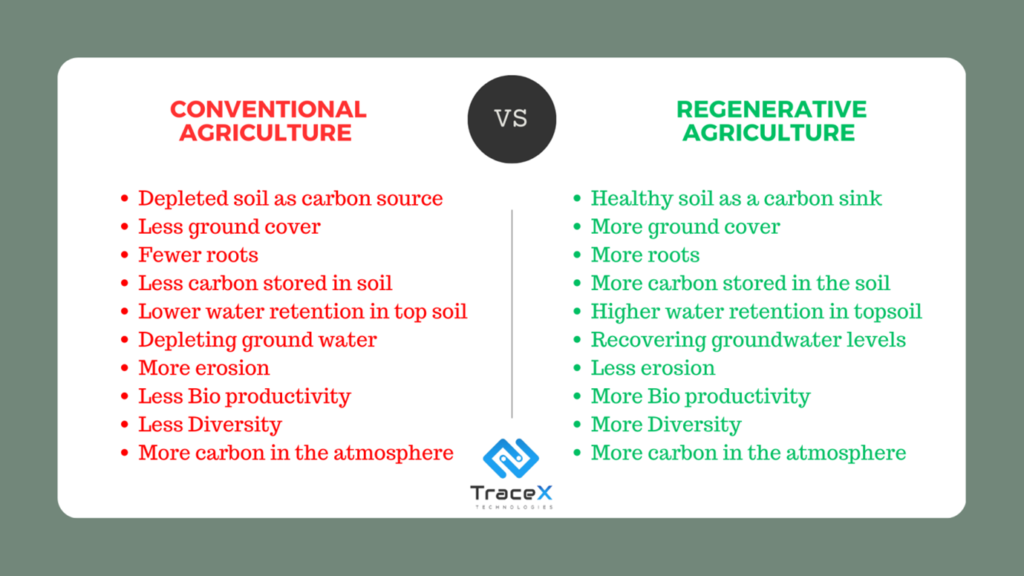
Starting with sustainable farming practices regenerative agriculture takes a bold step forward in reshaping our approach to food production. Unlike conventional methods that often deplete resources and harm ecosystems, regenerative agriculture focuses on nurturing the land while promoting ecological balance. It encompasses a range of practices such as cover cropping, rotational grazing, and agroforestry, all aimed at improving soil health, enhancing biodiversity, and sequestering carbon. By harnessing the power of nature and working with, rather than against, natural processes, regenerative agriculture not only ensures the long-term productivity of farmland but also contributes to mitigating climate change and preserving the planet for future generations.
Crop cover is an agriculture practice wherein a farmer plants certain crops with no intention of harvest. These are crops that help as cover crops that help in protecting, holding, and enhancing soil nutrients. Otherwise, the soil is vulnerable to washing out or being blown away by harsh weather.
Crop rotation is a change in planting crops seasonally, farmers plant different crops depending on certain factors which help land fertility and the absorption of nutrients. An example is to plant soya beans which infuses nitrogen into the soil, which acts as natural inputs to corn plantation in the next season.
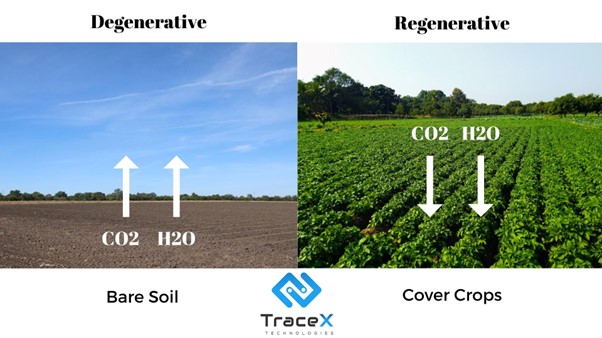
No-tilling or reduced tilling is practiced not to disturb soil’s naturally infused nutrients. It reduces the emission of carbon dioxide and prevents soil erosion. With the decrease in carbon emission, soil sequestration takes place in turn improving soil quality.
Livestock and Manure Management
Use of natural manure for pastureland fertility, to allow green grass to re-grow, maintain grazing cycle depending on animal’s natural behaviour, and the use of biological and natural enemies to control pests maintains the soil and plant quality. Artificial fertilizers emit chemicals into the water source and pollute the environment. These chemical pesticides are a threat to food safety. Non-pesticide management addresses these challenges and assures safe and quality food.
Agroforestry, a sustainable farming practice, integrates trees and shrubs into agricultural landscapes, offering a myriad of environmental, economic, and social benefits. By diversifying farm ecosystems, agroforestry enhances soil fertility, conserves water, and mitigates erosion, contributing to long-term land productivity. Moreover, the presence of trees provides habitats for wildlife, improves biodiversity, and sequesters carbon, thereby mitigating climate change.
Crop Residue Management
Crop residue management is a sustainable farming practice that involves the strategic handling of plant materials left after harvest, such as stalks, leaves, and roots. Instead of burning or discarding these residues, farmers can incorporate them back into the soil through techniques like mulching, composting, or ploughing. This practice offers numerous benefits, including improved soil health, enhanced water retention, and reduced erosion. By returning organic matter to the soil, crop residue management promotes nutrient cycling, increases microbial activity, and fosters a healthy soil ecosystem.
According to the Paris agreement, the greenhouse gas emissions must decrease by 50 % by 2030 and reach net-zero by 2030 to reduce the threat of climate change.
Net-zero is when the amount of GHG emissions put into the atmosphere is balanced with those taken out from the atmosphere thereby bringing the emissions to zero. The food industry must become net-zero to end climate change. It is claimed that continuing with a business-as-usual approach could see emissions rise by 30 to 40% by 2050, and if no changes are made in the industry, the goal to achieve the Paris target is highly impossible.
Regenerative farming on 40% of the world’s cropland would save around 600 million tons of emissions.
In order to reach the Paris agreement, these practices need to be scaled faster and move from the existing covering of 15% to 40% by 2030.
Regenerative agriculture practices such as no-tillage, cover cropping and crop rotation increase the soil organic matter and enhance the carbon storage in soils.
According to a study published in the journal Science Advances, regenerative agriculture practices can sequester carbon in soil at a rate of 0.4 to 1.2 tonnes per hectare per year.
This represents a significant opportunity to mitigate GHG emissions and combat climate change. According to USDA, these practices can increase soil organic matter up to 3% over 5 years, thereby improving water retention, nutrient recycling and crop yields.
Conventional agriculture practices such as the use of synthetic fertilizers and pesticides, tillage and monoculture farming contributes to GHG emissions. Regenerative practices like agroforestry, use of natural fertilizers and rotational grazing reduces emissions from agriculture by reducing the release of nitrous oxide and methane emissions and the usage of fossil fuels.
A report by Rodale states that Regenerative agriculture practices can increase crop yields by 78% compared to the conventional practices.
Crop diversification and cover crops create habitats for insects, pollinators and wildlife. The promotion of biodiversity in farming systems can enhance the ecosystem resilience, improve soil health and increase crop yields. Agroforestry practices can also provide habitat for forest dwelling species. Crop rotation and no tillage protects the microorganisms in the soil. The minimal use of chemical fertilizers and pesticides prevents the harming of biodiversity. Regenerative practices promote use of native plant species which are better adapted to local environmental conditions and can support a diverse range of insects and wildlife.
The regenerative practices help to boost soil health increase water infiltration and reduce soil erosion. Healthy soils support plant growth and build resilience in crop systems with increased crop yields and natural inputs.
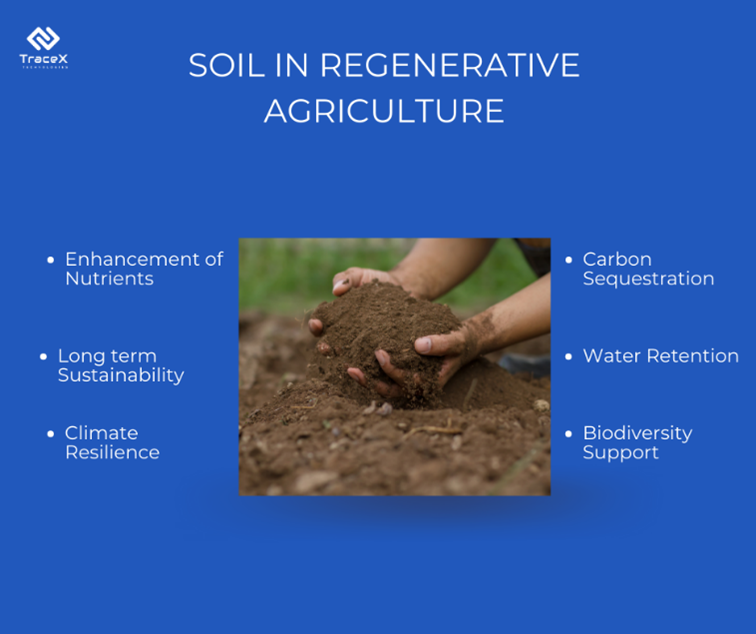
These practices contribute to achieving net-zero food systems and farmers can produce nutritious food while protecting the environment.
The implementation of regenerative agriculture might be a tedious and slow process but has to be practiced for a sustainable future. Some of its benefits are.
Use of less synthetic fertilizers and pesticides, conserving water and soil, promoting biodiversity and reducing GHG emissions
Promote social equity by providing fair wages, improving access to healthy food and supporting rural livelihoods.
Increase farm productivity, reduce input costs, create market linkages for growth and economic stability.
Reduce GHG emissions, sequester carbon to mitigate impacts of climate change.
Healthier food with reduced chemicals and use of organic practices.
Prioritizes production of healthy and nutritious food reducing hunger and increasing food security.
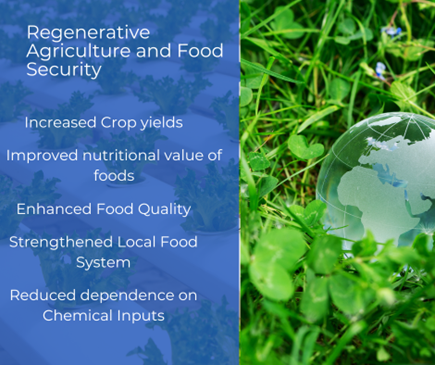
Regenerative agriculture is intricately connected to food security through its focus on enhancing soil health, biodiversity, and ecosystem resilience. By adopting regenerative practices such as cover cropping, crop rotation, and minimal soil disturbance, farmers can improve soil structure, nutrient availability, and water retention. This leads to increased crop yields, better resistance to pests and diseases, and reduced dependency on synthetic fertilizers and pesticides. Additionally, regenerative agriculture promotes the conservation of natural resources, such as water and biodiversity, which are essential for long-term food security. By fostering healthy and resilient ecosystems, regenerative agriculture helps ensure a stable and abundant food supply for current and future generations.
Regenerative agriculture platforms have the potential to drive innovation in the agribusiness industry by enabling new farming practices that prioritize soil health, biodiversity and ecosystem services. They provide farmers and enterprises the tools and resources to implement these regenerative agriculture practices and foster both knowledge sharing and collaboration among the various stakeholders.
According to Nielsen, 75 % of millennials are altering their buying habits with environment in mind. Enterprises in the likes of Pepsico, Unilever, Walmart and General Mills believe that consumers will be soon looking into purchasing regeneratively produced food because of their benefits.
The technology advances in satellites, sensors and blockchain can significantly contribute to building a regenerative agriculture platform that can track the performance of food producers by monitoring everything from carbon soil sequestration to carbon emissions to water usage and biodiversity.
There are several barriers in implementation of regenerative practices that can hinder the adoption and scalability of these practices.
Many farmers do not have the necessary knowledge or the training to implement these practices. The knowledge of the various practices and how they can be implemented as well as the technical skills needed are important.
Farmers producing food using these practices need to find consumers paying a premium for the sustainably produced food. The investments could prove high.
Implementing regenerative practices require investments. This could include purchasing new equipment, soil testing devices, hiring labour and farmers need financial support for these.
Data collection and aggregation should be accurate and economically viable. Manual systems are resource intensive and prone to errors.
Regulatory frameworks may hinder adoption of these practices in terms of policies favouring conventional agriculture practices. Farmers may find it difficult to transit.
TraceX farm management software and digital MRV platform empower farmers to adopt and sustain regenerative agriculture practices by providing them with the necessary tools and support to plan, monitor, and verify their efforts. This integrated approach helps address the challenges associated with transitioning to regenerative farming systems, ultimately promoting environmental sustainability and agricultural resilience.
Planning: The farm management software enables farmers to create detailed plans for implementing regenerative practices such as cover cropping, crop rotation, and agroforestry. Farmers can access a variety of resources and guidelines to design sustainable farming systems tailored to their specific needs and goals.
Monitoring: The software allows farmers to monitor the implementation of regenerative practices in real-time, tracking factors such as soil health, crop diversity, and water usage. Integrated sensors and IoT (Internet of Things) devices collect data on various environmental parameters, providing farmers with valuable insights into the effectiveness of their regenerative agriculture efforts.
The digital MRV platform facilitates the measurement, reporting, and verification of key sustainability metrics, ensuring compliance with regulatory requirements and certification standards. By accurately documenting and reporting their regenerative practices, farmers can demonstrate their commitment to environmental stewardship and access premium markets for sustainably produced agricultural products.
In conclusion, the journey towards regenerative agriculture signifies a transformative paradigm shift in the realm of farming. It is not merely a set of practices but a holistic commitment to fostering ecological balance, enriching soil health, and nurturing biodiversity. As we embrace regenerative agriculture, we embark on a path that goes beyond sustainability, aiming to rejuvenate our land and cultivate a harmonious relationship between agriculture and nature. This approach holds the promise of not only ensuring sustainable yields but also of creating resilient ecosystems capable of withstanding the challenges of a changing climate.
